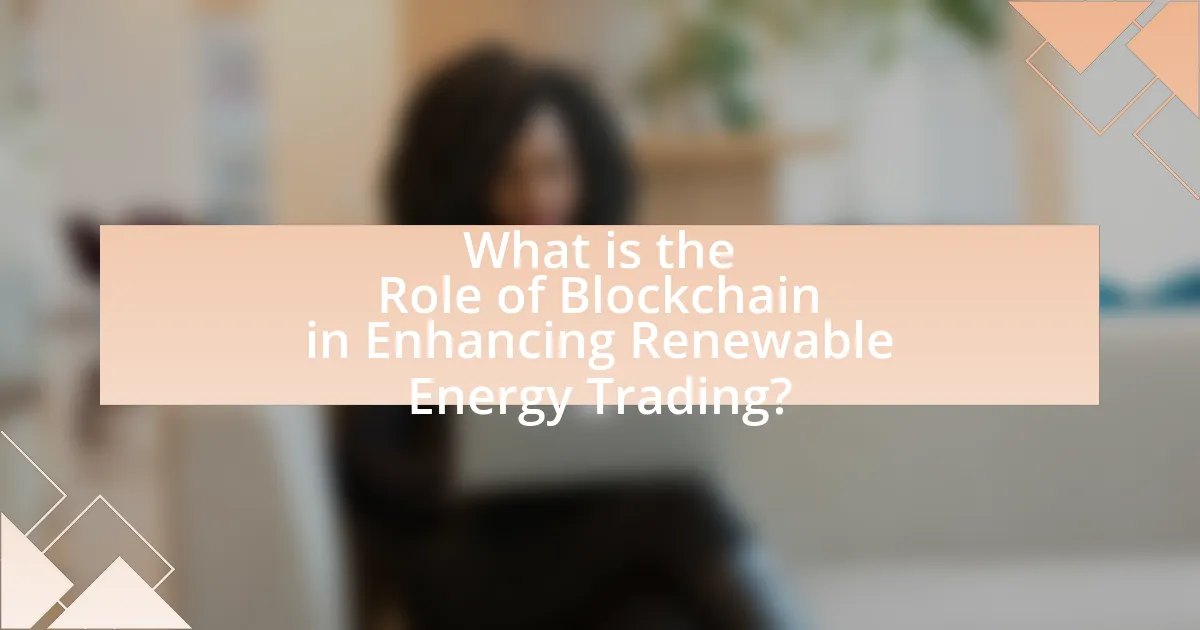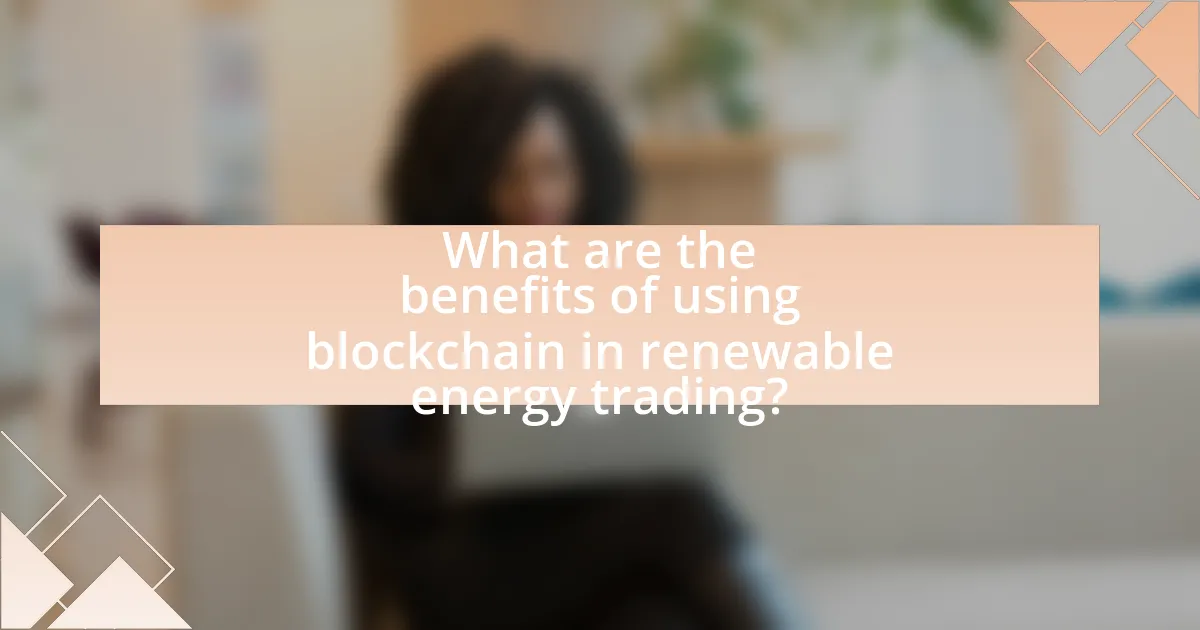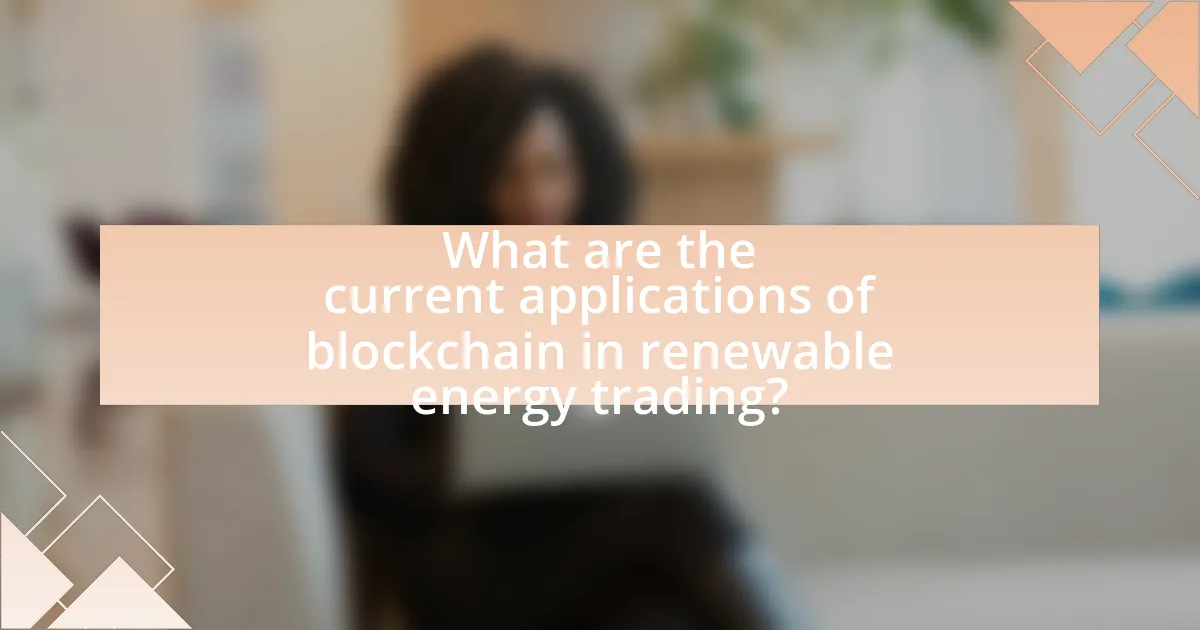Blockchain technology plays a pivotal role in enhancing renewable energy trading by providing a decentralized, transparent, and secure platform for transactions. It facilitates peer-to-peer energy trading, allowing consumers to buy and sell excess energy directly, which reduces costs and increases efficiency. Key features of blockchain, such as smart contracts and an immutable ledger, automate trading processes and ensure compliance, thereby fostering trust among participants. The article explores the benefits of blockchain in renewable energy trading, including increased transparency, reduced transaction costs, and improved market access for producers, while also addressing the challenges faced by the sector without blockchain integration. Additionally, it highlights current applications and innovative projects utilizing blockchain, as well as regulatory considerations and future trends in the energy market.

What is the Role of Blockchain in Enhancing Renewable Energy Trading?
Blockchain plays a crucial role in enhancing renewable energy trading by providing a decentralized and transparent platform for transactions. This technology enables peer-to-peer energy trading, allowing consumers to buy and sell excess energy directly without intermediaries, which reduces costs and increases efficiency. For instance, projects like Power Ledger have demonstrated that blockchain can facilitate real-time energy trading, ensuring that transactions are recorded securely and transparently. Additionally, blockchain’s smart contracts automate the trading process, ensuring compliance and reducing the risk of fraud. According to a report by the International Renewable Energy Agency (IRENA), blockchain can significantly lower transaction costs and enhance market access for renewable energy producers, thereby promoting a more sustainable energy ecosystem.
How does blockchain technology facilitate renewable energy trading?
Blockchain technology facilitates renewable energy trading by enabling decentralized, transparent, and secure transactions between energy producers and consumers. This technology allows for peer-to-peer energy trading, where individuals can buy and sell excess energy directly without intermediaries, reducing costs and increasing efficiency. For instance, platforms like Power Ledger utilize blockchain to track energy generation and consumption in real-time, ensuring that transactions are recorded immutably and transparently. This transparency builds trust among participants and encourages more investments in renewable energy sources, as evidenced by projects in Australia and Europe that have successfully implemented blockchain for energy trading.
What are the key features of blockchain that support energy trading?
The key features of blockchain that support energy trading include decentralization, transparency, security, and smart contracts. Decentralization allows for peer-to-peer transactions without intermediaries, reducing costs and increasing efficiency. Transparency ensures that all participants have access to the same information, fostering trust among users. Security is provided through cryptographic techniques that protect data integrity and prevent fraud. Smart contracts automate and enforce agreements between parties, streamlining the trading process. These features collectively enhance the efficiency and reliability of energy trading systems, as evidenced by projects like Power Ledger and LO3 Energy, which utilize blockchain to facilitate decentralized energy markets.
How does blockchain ensure transparency in renewable energy transactions?
Blockchain ensures transparency in renewable energy transactions by providing a decentralized and immutable ledger that records all transactions in real-time. This technology allows all participants in the energy market, including producers, consumers, and regulators, to access the same information, thereby reducing the potential for fraud and discrepancies. Each transaction is time-stamped and linked to previous transactions, creating a clear and traceable history of energy production and consumption. For instance, a study by the International Renewable Energy Agency (IRENA) highlights that blockchain can enhance the traceability of renewable energy certificates, ensuring that the energy claimed as renewable is indeed sourced from verified renewable sources. This level of transparency fosters trust among stakeholders and encourages greater participation in renewable energy markets.
Why is renewable energy trading important in today’s market?
Renewable energy trading is important in today’s market because it facilitates the efficient exchange of clean energy, promoting sustainability and reducing reliance on fossil fuels. This trading mechanism enables producers of renewable energy, such as solar and wind, to sell excess energy to consumers or other businesses, thereby optimizing energy distribution and enhancing grid stability. According to the International Renewable Energy Agency, renewable energy sources accounted for 29% of global electricity generation in 2020, highlighting the growing significance of this market. Furthermore, renewable energy trading supports the transition to a low-carbon economy by incentivizing investment in clean technologies and fostering competition, which can lead to lower energy prices for consumers.
What challenges does the renewable energy sector face without blockchain?
The renewable energy sector faces significant challenges without blockchain, primarily in transparency, efficiency, and trust. Without blockchain technology, the tracking of energy production and consumption becomes cumbersome, leading to inefficiencies in energy trading and distribution. For instance, traditional systems often rely on centralized databases that are prone to errors and fraud, which can undermine trust among stakeholders. Additionally, the lack of real-time data sharing hampers the ability to optimize energy usage and integrate diverse energy sources effectively. According to a report by the International Renewable Energy Agency (IRENA), the absence of decentralized systems can result in increased transaction costs and slower market responses, ultimately hindering the growth and adoption of renewable energy solutions.
How does blockchain address these challenges effectively?
Blockchain addresses challenges in renewable energy trading by providing a decentralized, transparent, and secure platform for transactions. This technology enables peer-to-peer energy trading, reducing reliance on intermediaries and lowering transaction costs. For instance, blockchain’s immutable ledger ensures that all transactions are recorded accurately and cannot be altered, which enhances trust among participants. Additionally, smart contracts automate and enforce agreements, facilitating real-time settlements and reducing delays. Research from the International Renewable Energy Agency highlights that blockchain can increase market efficiency and enable greater participation in renewable energy markets, thereby addressing issues of accessibility and scalability.

What are the benefits of using blockchain in renewable energy trading?
The benefits of using blockchain in renewable energy trading include increased transparency, enhanced security, and improved efficiency. Blockchain technology allows for real-time tracking of energy transactions, ensuring that all parties have access to the same information, which reduces the potential for fraud. Additionally, the decentralized nature of blockchain enhances security by eliminating single points of failure, making it more difficult for malicious actors to manipulate data. Furthermore, smart contracts on blockchain platforms automate transactions, reducing the time and costs associated with traditional trading methods. According to a report by the International Renewable Energy Agency, blockchain can lower transaction costs by up to 30%, demonstrating its potential to revolutionize the renewable energy market.
How does blockchain improve efficiency in energy trading?
Blockchain improves efficiency in energy trading by enabling transparent, secure, and automated transactions between energy producers and consumers. This technology eliminates intermediaries, reducing transaction costs and time delays associated with traditional energy trading methods. For instance, smart contracts on blockchain platforms automatically execute trades when predefined conditions are met, ensuring faster settlement and reducing the risk of human error. Additionally, blockchain’s decentralized ledger provides real-time visibility into energy transactions, enhancing trust among participants and facilitating peer-to-peer energy trading. Studies have shown that implementing blockchain in energy markets can lead to a reduction in operational costs by up to 30%, demonstrating its significant impact on efficiency.
What role does smart contracts play in enhancing trading efficiency?
Smart contracts significantly enhance trading efficiency by automating and streamlining transaction processes. They execute predefined agreements automatically when conditions are met, reducing the need for intermediaries and minimizing delays. For instance, in renewable energy trading, smart contracts can facilitate real-time transactions between producers and consumers, ensuring that energy is traded instantly and securely. This automation leads to faster settlement times and lower transaction costs, as evidenced by a study from the International Renewable Energy Agency, which found that blockchain technology, including smart contracts, can reduce transaction costs by up to 30%.
How does blockchain reduce transaction costs for energy traders?
Blockchain reduces transaction costs for energy traders by enabling direct peer-to-peer transactions without intermediaries. This decentralized approach eliminates the need for traditional financial institutions, which typically charge fees for processing transactions. Additionally, blockchain’s transparent and immutable ledger reduces the costs associated with fraud and disputes, as all transactions are recorded in real-time and can be easily verified. According to a study by the International Renewable Energy Agency, implementing blockchain technology in energy trading can lower transaction costs by up to 30%, demonstrating its effectiveness in streamlining processes and enhancing efficiency in the energy market.
What impact does blockchain have on energy consumers and producers?
Blockchain significantly impacts energy consumers and producers by enabling decentralized energy trading and enhancing transparency in transactions. This technology allows consumers to buy and sell excess energy directly to one another, fostering peer-to-peer energy markets. For instance, a study by the International Renewable Energy Agency (IRENA) highlights that blockchain can reduce transaction costs and increase market efficiency, making renewable energy more accessible. Additionally, blockchain’s immutable ledger ensures that all transactions are recorded transparently, which builds trust among participants and facilitates regulatory compliance. This shift empowers consumers to take control of their energy usage while providing producers with new revenue streams and market opportunities.
How does blockchain empower consumers in the energy market?
Blockchain empowers consumers in the energy market by enabling peer-to-peer energy trading, which allows individuals to buy and sell excess energy directly with one another. This decentralized approach reduces reliance on traditional energy providers, enhances transparency in transactions, and lowers costs for consumers. For instance, platforms like Power Ledger have demonstrated that blockchain can facilitate real-time energy trading, allowing consumers to optimize their energy usage and maximize financial returns from renewable energy sources. Additionally, blockchain’s immutable ledger ensures that all transactions are secure and verifiable, fostering trust among participants in the energy market.
What advantages do energy producers gain from blockchain integration?
Energy producers gain several advantages from blockchain integration, including enhanced transparency, improved efficiency, and reduced transaction costs. Blockchain technology allows for real-time tracking of energy production and consumption, which increases transparency in energy trading. This transparency helps build trust among stakeholders and facilitates peer-to-peer energy trading, enabling producers to sell excess energy directly to consumers without intermediaries. Additionally, blockchain streamlines administrative processes, automating transactions and reducing the time and resources needed for settlement. A study by the International Renewable Energy Agency (IRENA) highlights that blockchain can lower transaction costs by up to 30%, making energy trading more economically viable for producers.

What are the current applications of blockchain in renewable energy trading?
Current applications of blockchain in renewable energy trading include peer-to-peer energy trading, decentralized energy marketplaces, and enhanced transparency in renewable energy certificates. Peer-to-peer energy trading allows consumers to buy and sell excess energy directly with one another, facilitated by smart contracts on blockchain platforms, which automate transactions and ensure trust. Decentralized energy marketplaces leverage blockchain to create platforms where renewable energy producers can connect with buyers without intermediaries, reducing costs and increasing efficiency. Furthermore, blockchain enhances transparency in renewable energy certificates by providing a tamper-proof ledger that tracks the generation and ownership of renewable energy, ensuring authenticity and preventing fraud. These applications demonstrate how blockchain technology is transforming the renewable energy sector by promoting efficiency, reducing costs, and increasing trust among participants.
Which companies are leading the way in blockchain-based energy trading?
Companies leading the way in blockchain-based energy trading include Power Ledger, LO3 Energy, and WePower. Power Ledger, an Australian company, utilizes blockchain technology to enable peer-to-peer energy trading, allowing consumers to buy and sell excess renewable energy directly. LO3 Energy, based in the United States, has developed a platform called Exergy that facilitates local energy trading among consumers and producers. WePower, a European company, uses blockchain to streamline the procurement of renewable energy by allowing companies to purchase energy directly from producers through smart contracts. These companies exemplify the innovative use of blockchain to enhance transparency and efficiency in energy trading.
What innovative projects are utilizing blockchain for renewable energy?
Innovative projects utilizing blockchain for renewable energy include Power Ledger, which enables peer-to-peer energy trading, and WePower, which allows renewable energy producers to raise capital by selling energy in advance. Power Ledger has successfully implemented its platform in Australia, facilitating local energy trading and enhancing grid efficiency. WePower has partnered with various energy producers in Europe, demonstrating how blockchain can streamline transactions and improve transparency in energy markets. These projects exemplify how blockchain technology can enhance the efficiency and accessibility of renewable energy trading.
How are these projects shaping the future of energy trading?
These projects are shaping the future of energy trading by leveraging blockchain technology to enhance transparency, efficiency, and security in transactions. Blockchain enables decentralized energy trading platforms, allowing consumers and producers to engage directly without intermediaries, which reduces costs and increases market access. For instance, projects like Power Ledger and LO3 Energy have demonstrated successful peer-to-peer energy trading, where users can buy and sell excess renewable energy directly, fostering local energy markets. This shift not only promotes the adoption of renewable energy sources but also empowers consumers, as evidenced by the increased participation in energy trading platforms, which has grown significantly in recent years.
What are the regulatory considerations for blockchain in energy trading?
Regulatory considerations for blockchain in energy trading include compliance with existing energy market regulations, data privacy laws, and anti-money laundering (AML) requirements. Energy trading operates within a framework governed by national and regional regulations, which dictate how transactions are conducted, reported, and settled. For instance, the European Union’s Electricity Regulation mandates transparency and non-discrimination in energy markets, which blockchain can facilitate through immutable transaction records. Additionally, blockchain systems must adhere to data protection regulations like the General Data Protection Regulation (GDPR) in Europe, ensuring that personal data is handled appropriately. Furthermore, blockchain implementations in energy trading must align with AML regulations to prevent illicit activities, necessitating robust identity verification processes. These regulatory frameworks are essential for fostering trust and ensuring the legitimacy of blockchain applications in the energy sector.
How do regulations impact the implementation of blockchain technology?
Regulations significantly impact the implementation of blockchain technology by establishing legal frameworks that dictate how blockchain can be utilized within various sectors, including renewable energy trading. For instance, regulations can determine the compliance requirements for data privacy, security, and transaction transparency, which are crucial for blockchain applications. In the renewable energy sector, specific regulations may govern how energy credits are traded, affecting how blockchain systems are designed to facilitate these transactions. The European Union’s General Data Protection Regulation (GDPR) exemplifies how data protection laws can influence blockchain deployment, as companies must ensure that their blockchain solutions comply with stringent data handling and user consent requirements. This regulatory landscape shapes the operational capabilities of blockchain technology, influencing its adoption and integration into existing systems.
What are the best practices for compliance in blockchain energy trading?
The best practices for compliance in blockchain energy trading include ensuring adherence to regulatory frameworks, implementing robust data privacy measures, and conducting regular audits. Regulatory compliance is critical as it aligns blockchain operations with local and international laws, such as the European Union’s General Data Protection Regulation (GDPR) and energy market regulations. Data privacy measures protect sensitive information, ensuring that user data is encrypted and securely stored, which is essential for maintaining trust and legal compliance. Regular audits help identify and rectify compliance gaps, ensuring that blockchain systems operate transparently and in accordance with established standards. These practices collectively enhance the integrity and reliability of blockchain applications in the energy trading sector.
What are the future trends for blockchain in renewable energy trading?
Future trends for blockchain in renewable energy trading include increased decentralization, enhanced transparency, and the integration of smart contracts. Decentralization allows for peer-to-peer energy trading, enabling consumers to buy and sell energy directly, which can reduce reliance on traditional energy providers. Enhanced transparency through blockchain’s immutable ledger ensures that all transactions are recorded and verifiable, fostering trust among participants. The integration of smart contracts automates transactions based on predefined conditions, streamlining processes and reducing administrative costs. According to a report by the International Renewable Energy Agency (IRENA), blockchain technology could significantly lower transaction costs and improve market efficiency in renewable energy trading.
How is the adoption of blockchain expected to evolve in the energy sector?
The adoption of blockchain in the energy sector is expected to evolve through increased integration in renewable energy trading platforms, enhancing transparency and efficiency. As energy markets shift towards decentralized models, blockchain technology will facilitate peer-to-peer energy trading, allowing consumers to buy and sell excess energy directly. A report by the International Energy Agency indicates that blockchain can reduce transaction costs by up to 30%, making it a viable solution for managing decentralized energy resources. Furthermore, pilot projects, such as Power Ledger in Australia, demonstrate successful implementations of blockchain for tracking renewable energy certificates, showcasing its potential to streamline processes and improve market access for renewable energy producers.
What technological advancements could enhance blockchain’s role in energy trading?
Technological advancements such as smart contracts, Internet of Things (IoT) integration, and improved consensus algorithms could significantly enhance blockchain’s role in energy trading. Smart contracts automate transactions and enforce agreements without intermediaries, increasing efficiency and reducing costs. IoT devices enable real-time data collection and monitoring of energy consumption and production, facilitating more accurate trading and grid management. Improved consensus algorithms, like proof of stake, enhance scalability and energy efficiency of blockchain networks, making them more suitable for high-frequency trading in energy markets. These advancements collectively contribute to a more transparent, efficient, and decentralized energy trading ecosystem.
What practical steps can stakeholders take to leverage blockchain in renewable energy trading?
Stakeholders can leverage blockchain in renewable energy trading by implementing decentralized platforms for peer-to-peer energy transactions. These platforms enable direct trading between producers and consumers, reducing reliance on intermediaries and lowering transaction costs. For instance, using smart contracts on blockchain can automate the execution of trades based on predefined conditions, ensuring transparency and efficiency in transactions. Additionally, stakeholders should collaborate with technology providers to develop user-friendly interfaces that facilitate participation in blockchain networks. Research indicates that blockchain can enhance trust and security in energy trading, as it provides an immutable record of transactions, which is crucial for regulatory compliance and auditing.